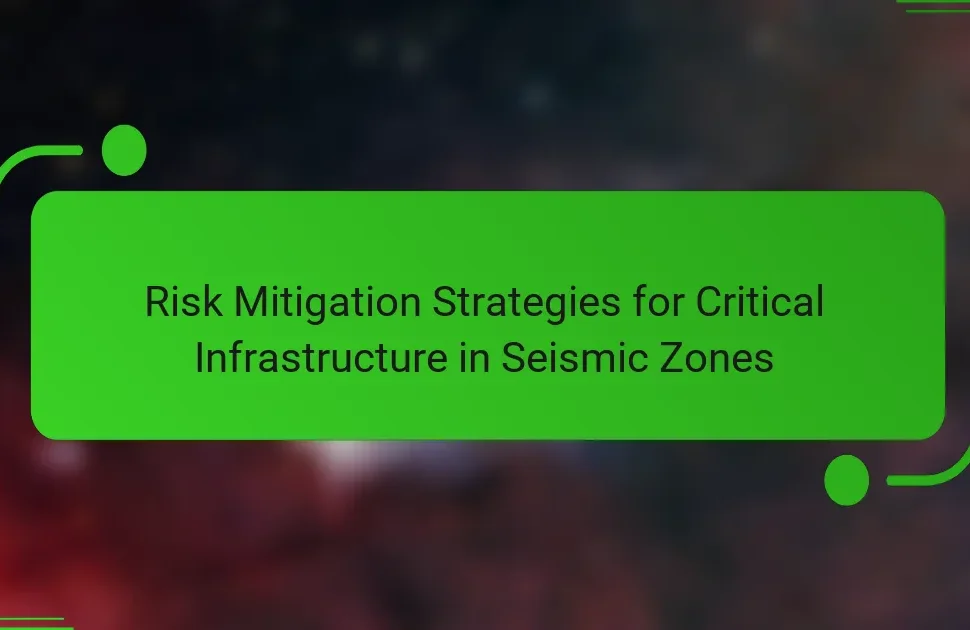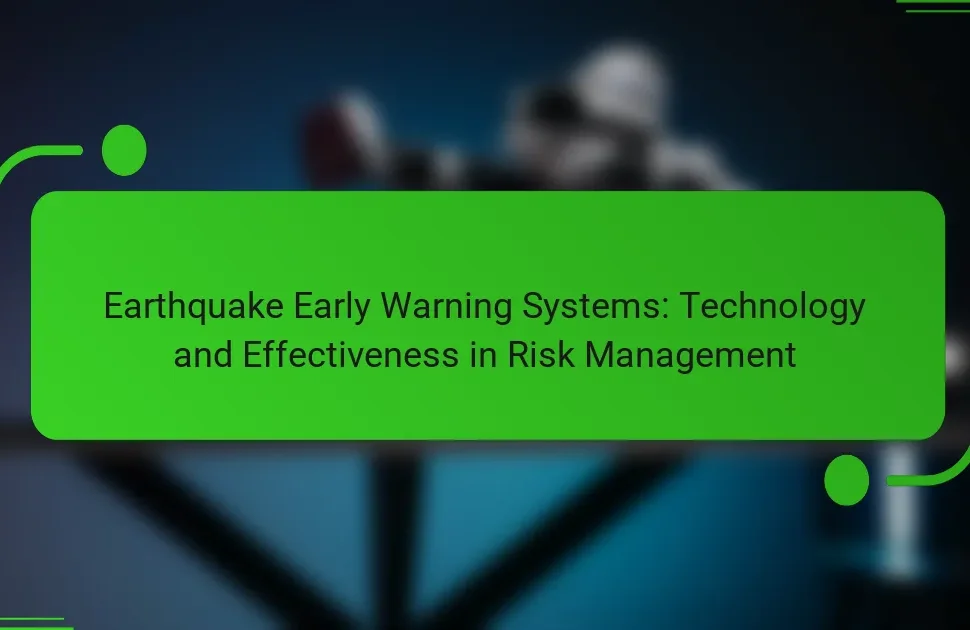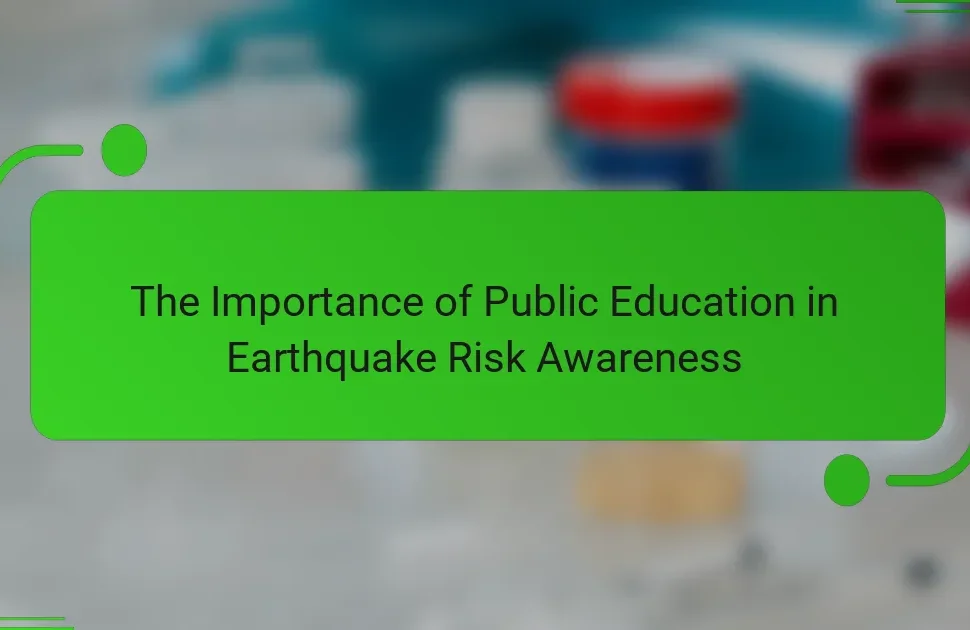Ground motion in seismology refers to the shaking of the ground caused by seismic waves during an earthquake, significantly impacting how structures respond to such events. Key parameters influencing ground motion include seismic source characteristics, distance from the epicenter, and local geological conditions. This article explores how variations in ground motion, as demonstrated by historical earthquakes like the 1994 Northridge event, inform engineering practices and influence building design. By analyzing ground motion data, engineers can assess site-specific risks and develop resilient structures that adhere to building codes and standards for earthquake-prone areas. Understanding these factors is essential for enhancing structural safety and performance during seismic activities.

What is Ground Motion in Seismology?
Ground motion in seismology refers to the shaking of the ground caused by seismic waves during an earthquake. This phenomenon is crucial for understanding how structures respond to seismic events. Ground motion can be measured in terms of acceleration, velocity, and displacement. Each of these parameters provides insights into the intensity and impact of an earthquake. Research shows that ground motion characteristics vary based on factors like distance from the epicenter and local geological conditions. For instance, the 1994 Northridge earthquake demonstrated significant variations in ground motion across different locations, influencing building design and safety measures. Understanding ground motion helps engineers create structures that can withstand seismic forces effectively.
How is Ground Motion Measured?
Ground motion is measured using instruments called accelerometers. These devices detect the acceleration of ground movement during seismic events. Data from accelerometers is recorded in three dimensions: vertical and two horizontal axes. This information helps to quantify the intensity and characteristics of ground shaking. Seismographs are also used to measure ground motion, capturing both acceleration and velocity. The recorded data is analyzed to assess potential impacts on structures. Ground motion measurements are essential for designing earthquake-resistant buildings. Studies show that accurate measurements can improve safety and reduce damage during seismic events.
What Instruments are Used to Measure Ground Motion?
Seismometers are the primary instruments used to measure ground motion. They detect and record the vibrations caused by seismic waves. Accelerometers are another type of instrument that measures the acceleration of ground motion. These devices provide real-time data on the intensity of shaking. Additionally, GPS sensors can track ground displacement during seismic events. Each instrument plays a crucial role in understanding seismic activity. This data is essential for assessing risks and designing resilient structures.
How Do Different Measurement Techniques Affect Data Accuracy?
Different measurement techniques significantly affect data accuracy in seismology. Techniques such as GPS, accelerometers, and seismometers have varying precision levels. GPS provides high spatial accuracy but may lack temporal resolution. Accelerometers capture rapid motion changes with high temporal accuracy but can be sensitive to noise. Seismometers offer a balance of spatial and temporal accuracy, but their calibration is crucial. The choice of technique influences data quality and reliability. For instance, a study by the US Geological Survey found that GPS measurements can have errors up to 2 cm in certain conditions. In contrast, accelerometer data can vary by 5% due to environmental interference. Thus, selecting the appropriate measurement technique is essential for ensuring accurate data in ground motion analysis.
Why is Understanding Ground Motion Important for Structural Design?
Understanding ground motion is crucial for structural design to ensure safety and stability during seismic events. Ground motion affects how structures respond to earthquakes. Engineers analyze ground motion to determine the forces acting on buildings. This analysis helps in designing structures that can withstand these forces. For instance, the 1994 Northridge earthquake revealed vulnerabilities in many buildings. Structures that were not designed with ground motion data suffered extensive damage. By incorporating ground motion parameters, engineers can improve resilience. This leads to safer buildings and reduced risk of collapse during earthquakes.
What Risks Does Ground Motion Pose to Structures?
Ground motion poses several risks to structures, primarily including damage, collapse, and failure of structural integrity. These risks arise from the vibrations and movements caused by seismic activity. Ground shaking can lead to the displacement of building foundations. This displacement can result in cracks in walls, ceilings, and floors. Additionally, severe ground motion can cause structural components to fail. For example, beams and columns may buckle under excessive stress. Historical data shows that buildings in high seismic zones are particularly vulnerable. The 1994 Northridge earthquake in California caused over $44 billion in damages due to ground motion effects. Understanding these risks is crucial for effective structural design in seismically active regions.
How Can Knowledge of Ground Motion Improve Safety?
Knowledge of ground motion can significantly improve safety during seismic events. Understanding the characteristics of ground motion helps engineers design structures that can withstand earthquakes. Accurate data on ground motion allows for better risk assessment and mitigation strategies. For instance, buildings can be constructed with materials and techniques that enhance their resilience. Research shows that structures designed with ground motion data can reduce damage by up to 50%. Additionally, knowledge of ground motion informs emergency response plans, ensuring timely evacuations and resource allocation. Overall, informed design and planning based on ground motion data lead to enhanced public safety during seismic activities.

What Parameters Affect Ground Motion?
Ground motion is influenced by several parameters. Key parameters include seismic source characteristics, such as magnitude and depth. Distance from the epicenter significantly affects ground motion intensity. Local geological conditions also play a critical role. Soil type and layering can amplify or dampen seismic waves. Building design and materials impact how structures respond to ground motion. The frequency content of seismic waves determines their effects on different structures. Historical data shows that these parameters collectively shape ground motion behavior during earthquakes.
How Does the Geological Context Influence Ground Motion?
Geological context significantly influences ground motion during seismic events. Factors such as soil composition, rock type, and geological structures affect how seismic waves propagate. Soft soils amplify ground motion, while hard rocks may diminish it. The presence of faults can also redirect seismic waves, altering their intensity and direction. Historical data shows that areas with loose, unconsolidated sediments experience higher ground shaking. For instance, the 1989 Loma Prieta earthquake demonstrated that regions with sedimentary basins experienced more intense shaking compared to adjacent bedrock areas. This relationship between geological context and ground motion is critical for designing earthquake-resistant structures.
What Role Do Soil Types Play in Ground Motion Variability?
Soil types significantly influence ground motion variability during seismic events. Different soil compositions affect how seismic waves propagate. For instance, soft soils can amplify ground motion, while hard soils may reduce it. Research shows that soft clay can increase shaking intensity by 2 to 3 times compared to bedrock. Conversely, dense gravel tends to dampen vibrations. The depth and layering of soil also contribute to this variability. Studies indicate that site-specific soil conditions can alter the expected ground motion by up to 50%. Understanding these effects is crucial for seismic design and safety.
How Does Bedrock Composition Impact Ground Motion?
Bedrock composition significantly impacts ground motion during seismic events. Different types of bedrock, such as granite or sedimentary rock, have distinct physical properties. These properties influence how seismic waves travel through the ground. Denser bedrock tends to transmit seismic waves more efficiently. This can lead to stronger ground motion at the surface. Conversely, softer or more fractured bedrock can absorb and dissipate energy. This results in reduced ground motion. Research shows that locations built on solid bedrock experience less shaking. In contrast, areas on softer soils may face amplified ground motion. This understanding is crucial for structural design in seismically active regions.
What Are the Key Characteristics of Ground Motion?
Key characteristics of ground motion include amplitude, frequency, duration, and direction. Amplitude refers to the maximum displacement of the ground during seismic activity. Frequency indicates how often the ground motion occurs, typically measured in Hertz. Duration is the length of time that ground shaking lasts, which can affect structural response. Direction describes the orientation of ground motion, which can vary based on seismic wave propagation. These characteristics influence how structures respond to seismic events, impacting design and safety. For instance, buildings in high-amplitude areas may require additional reinforcement to withstand severe shaking.
What is the Significance of Frequency and Amplitude in Ground Motion?
Frequency and amplitude are crucial parameters in ground motion analysis. Frequency refers to how often ground motion oscillates in a given time period. Higher frequencies can lead to more intense shaking, affecting structures differently than lower frequencies. Amplitude measures the strength or magnitude of ground motion. Greater amplitude indicates stronger shaking, which can result in more significant structural damage. Research shows that structures respond variably to different frequencies and amplitudes during seismic events. For example, buildings may sway more at specific resonant frequencies, leading to potential failure. Understanding these parameters aids engineers in designing buildings that can withstand seismic forces effectively.
How Do Duration and Waveform Shape Affect Structural Response?
Duration and waveform shape significantly influence structural response during seismic events. Longer durations of ground motion can lead to increased energy absorption by structures. This extended exposure may result in cumulative damage over time. Conversely, short-duration motions may cause sudden, intense forces that structures must withstand. Waveform shape affects how these forces are distributed across a structure. For instance, sinusoidal waveforms create different stress patterns compared to triangular or square waveforms. Structural materials respond variably based on these shapes, impacting overall stability. Research indicates that structures designed for specific waveform characteristics perform better during earthquakes. Therefore, understanding these parameters is crucial for effective seismic design.

How Do Engineers Use Ground Motion Data in Structural Design?
Engineers use ground motion data to inform and enhance structural design. This data helps in understanding how structures respond to seismic events. Engineers analyze ground motion records to determine potential forces acting on buildings during earthquakes. They utilize this information to create models that predict structural behavior under various seismic conditions. Ground motion data allows engineers to assess site-specific risks and design accordingly. For instance, they may choose materials and structural systems that can withstand expected ground movements. Additionally, engineers apply this data in the development of building codes and standards. These codes ensure that structures are resilient and safe in earthquake-prone areas.
What Design Strategies Mitigate the Effects of Ground Motion?
Design strategies that mitigate the effects of ground motion include base isolation, energy dissipation systems, and structural reinforcement. Base isolation involves placing flexible bearings between a structure and its foundation. This allows the building to move independently of ground motion. Energy dissipation systems absorb and dissipate seismic energy, reducing forces on the structure. Structural reinforcement enhances the strength and ductility of materials used in construction. Techniques such as cross-bracing and shear walls are commonly employed. Research shows that these strategies significantly reduce damage during seismic events. For example, structures with base isolation can experience up to 90% less seismic force.
How Do Building Codes Incorporate Ground Motion Data?
Building codes incorporate ground motion data by utilizing seismic hazard assessments. These assessments analyze potential ground shaking in specific geographic areas. Building codes then set requirements for structural design based on this data. For example, codes may specify materials, structural systems, and safety factors to withstand predicted ground motions. The International Building Code (IBC) is one framework that employs this methodology. It uses ground motion data from sources like the US Geological Survey (USGS). This ensures that structures are resilient to earthquakes, enhancing public safety.
What Role Does Retrofitting Play in Enhancing Structural Resilience?
Retrofitting significantly enhances structural resilience by upgrading existing buildings to withstand seismic forces. This process involves reinforcing structural elements such as beams, columns, and foundations. Retrofitting can improve a building’s ability to absorb and dissipate energy during an earthquake. Studies show that retrofitted structures experience less damage and lower repair costs post-event. For example, the Federal Emergency Management Agency (FEMA) reports that retrofitting can reduce earthquake-related losses by up to 50%. Furthermore, retrofitting techniques include adding steel braces, base isolators, and damping systems. These modifications increase stability and extend the lifespan of structures. Therefore, retrofitting is essential for enhancing the resilience of buildings in seismic zones.
What Are Best Practices for Considering Ground Motion in Design?
Best practices for considering ground motion in design include conducting site-specific seismic hazard assessments. These assessments evaluate the potential ground motion levels based on local geological conditions. Engineers should use probabilistic seismic hazard analysis (PSHA) to quantify the likelihood of different ground motion scenarios. Incorporating building codes that reflect regional seismic risks is essential for safety. Utilizing performance-based design approaches allows for tailored structural responses to expected ground motions. Continuous monitoring of ground motion data can inform future design improvements. Collaboration with geotechnical engineers enhances understanding of soil-structure interaction. Implementing redundancy in structural systems increases resilience to unexpected ground motions.
How Can Engineers Stay Updated on Ground Motion Research?
Engineers can stay updated on ground motion research by regularly reviewing academic journals and attending conferences. Key journals include the Journal of Seismology and the Bulletin of the Seismological Society of America. These publications feature the latest studies and findings in the field. Conferences such as the Seismological Society of America Annual Meeting provide networking opportunities and insights into new research. Additionally, joining professional organizations like the Earthquake Engineering Research Institute can offer access to resources and webinars. Online platforms like ResearchGate and Google Scholar allow engineers to follow specific researchers and topics. Engaging with social media channels focused on seismology can also provide real-time updates. These methods ensure engineers remain informed about advancements and trends in ground motion research.
What Tools and Resources Are Available for Ground Motion Analysis?
Ground motion analysis utilizes various tools and resources. These include software programs like SHAKE, which analyzes soil-structure interaction. Another tool is OpenSees, a framework for simulating structural response to earthquakes. Seismographs are essential instruments that measure ground motion. Ground motion prediction equations (GMPEs) offer statistical models for estimating ground shaking. Data repositories like the US Geological Survey (USGS) provide access to seismic data. Additionally, educational resources and research papers enhance understanding of ground motion analysis techniques. These tools collectively support engineers and researchers in assessing seismic risks and designing resilient structures.
Ground motion is a critical phenomenon in seismology, referring to the shaking of the ground caused by seismic waves during earthquakes. This article explores the parameters affecting ground motion, including measurement techniques, geological influences, and their implications for structural design. Key topics include the role of accelerometers and seismometers in measuring ground motion, the impact of soil types and bedrock composition on seismic wave propagation, and design strategies to enhance structural resilience against seismic forces. Understanding these elements is essential for engineers to create safe and effective buildings in earthquake-prone areas.




